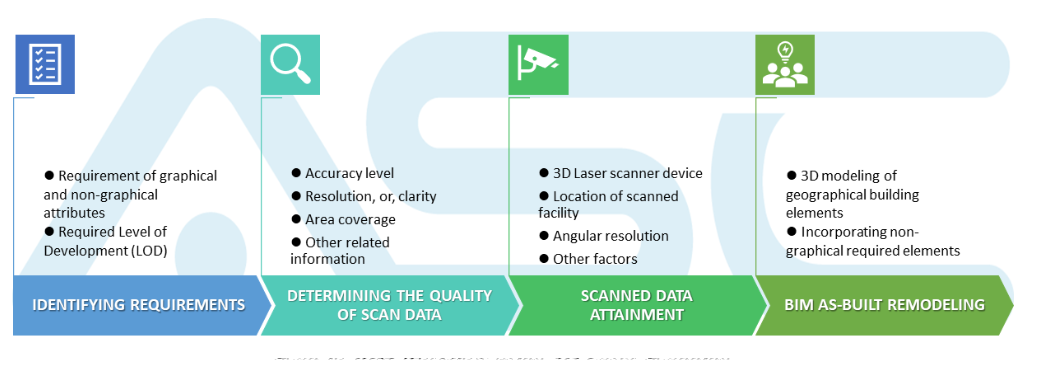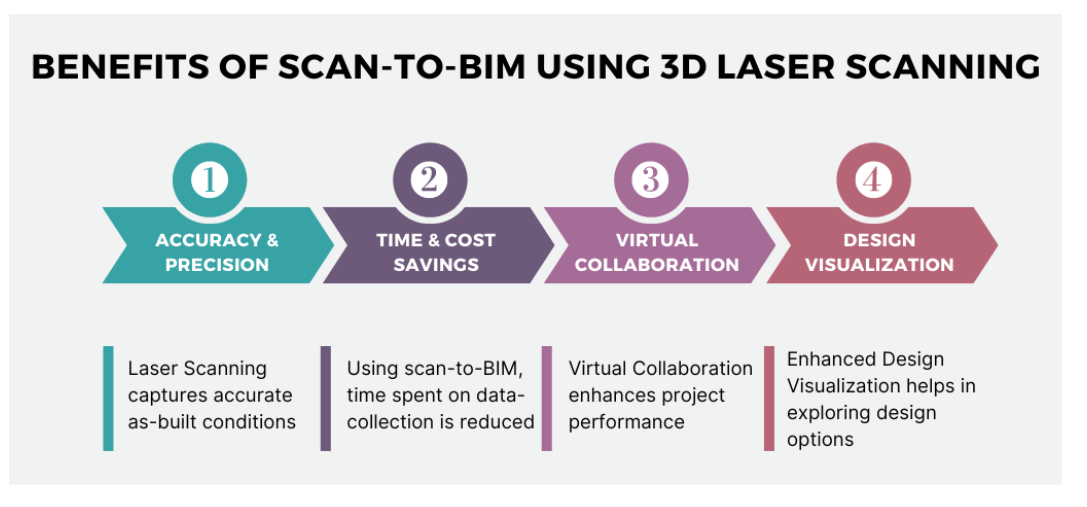How technologies like Scan-to-BIM and 3D Laser Scanning are Transforming the Construction Industry?
Explore how scan-to-BIM and 3D laser scanning are revolutionizing architectural design with enhanced effectiveness, precision, and innovation.
Construction companies can create virtual models for monitoring or renovation by using laser scanning to create 3D scans of their current projects. Growing in the AEC sector is possible because of its design and operating simplicity combined with laser scanning's dependability. As-built virtual models save expenses associated with incorrect rework, speed up decision-making, and help assess structure. Scanning services are gaining popularity in construction procedures as the building and design industry experiences fast global alterations. In-depth coverage of the effectiveness of 3D laser scanning and scan-to-BIM technologies for building projects will be provided in this article.
Understanding Scan to BIM and 3D Laser Scanning
To commence, an understanding of how these technologies work and how they are changing the traditional design process is important before we look at the effect of Scan-to-BIM and 3D laser scanning on architectural design.
Scan-to-BIM
Converting building or site attributes, into a Building Information Model using the scan-to-BIM 3D laser scanning process results in 3D models of structural components architectural details, and MEP systems. These models are valuable, for design, visualization clash detection, renovations, and facility management purposes. By automating measurements and minimizing design mistakes this process streamlines workflows effectively.
3D Laser Scanning
For construction projects, 3D Laser Scanning offers precise as-built site data, quickly and efficiently collecting structural, architectural, MEP, subsurface utility, and concrete reinforcing elements. Construction, rehabilitation, prefabrication, asset management, and facility improvements may all be completed more quickly and efficiently with its affordable visualization solution, which also lowers errors.
Scan-to-BIM and 3D laser scanning advantages
Given their many advantages that are transforming the way architects approach projects and collaborate with clients, consultants, and builders, scan-to-BIM and 3D laser scanning technologies are quickly becoming popular in the architectural design field. Leading advantages include a few of these:
Accuracy and Precision
By using 3D laser scanning to capture current circumstances and create digital models, Scan-to-BIM provides high accuracy and precision. With fewer mistakes and hence more possibilities of success, architects can rely on this accuracy to improve their decision-making process.
Time & Cost savings
Scan-to-BIM and 3D laser scanning speed up the design phase by reducing time spent on data collection. In addition, project delays are reduced while timely budget-friendly delivery is ensured.
Virtual Collaboration
Scan-to-BIM and 3D laser scanning allow for virtual collaboration among architects, engineers, contractors, and clients thereby improving communication and enhancing coordination between these stakeholders leading to more efficient project delivery.
Design Visualization
Scan-to-BIM technology combined with 3D Laser Scanning provides architects with powerful visualization tools that aid in exploring various design options by assessing spatial relationships along with ideas’ effective communication. With these tools, it is possible to visualize project outcomes.
Future Implications and Opportunities
The integration of Scan-to-BIM and 3D laser scanning technologies in architectural design is enhancing virtual environments, sustainable practices, and digital twin technology. These advancements also enable parametric designing and generative modeling, enhancing productivity and promoting sustainable built environments.
Conclusion
The new technologies such as, “scan-to-BIM and 3D laser scanning” are changing architectural design in terms of enhanced effectiveness as well as better precision and innovation. Through these instruments, architects can capture existing conditions, construct digital models, and collaborate with the stakeholders. These technologies have the potential to create room for more innovations thus improving our physical environment although cost and data management are problematic.
FAQ
1. How can 3D laser scanning and SCAN to BIM improve the construction process?
The construction processes have been improved by 3D laser scanning and Scan to BIM in a way that provides accurate documentation, clash detection, better project planning, quality control assurance, as well as safety promotion.
2. What are the major applications of 3D laser scanning in architectural design?
3D laser scanning technology is crucial in architectural design for accurate documentation, site analysis, planning, BIM, historic preservation, architectural design proposals, and construction monitoring, including virtual reality.
3. How accurate are models produced by 3D laser scanners?
High-resolution 3D laser scanner data enhances digital model accuracy by automating modeling and detecting collisions between model elements and the environment, minimizing human error.
4. What are the visualization tools in Scan to BIM Design?
Scan-to-BIM or even 3D Laser Scanning methods help increase precision within digital models through higher resolution content gathering minimize human errors automation of designing along with collision detection among other factors.
5. What are some problems faced with Scan to BIM and 3D laser scanning?
Scan to Bim has various challenges including 3D laser scanning compatibility issues data quality alignment accuracy time cost interpretation integration, and client understanding legal issues leading to incorrect or incomplete models.
6. How is architectural design influenced by automation and artificial intelligence?
Architecture is being transformed by automation and AI, enabling efficient data acquisition, modeling, analysis, and optimization that yield detailed visualizations, energy performance optimization, and informed design decisions.
Source: https://www.marsbim.com/services/bim/scan-to-bim.html














